Zoom
Trash

Dash_index. MJC8 Q400. PW150A. Le PW150A, d’une puissance de 5 000 SHP, procure au marché des avions de 70 à 80 places la vitesse d’un jet et les avantages de la turbopropulsion – faible consommation, faibles émissions atmosphériques et coûts d’exploitation imbattables – sans parler de cette fiabilité inégalée qui fait le renom de P&WC.
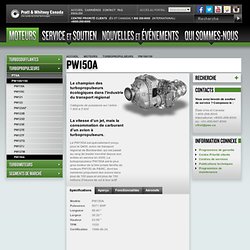
Les avions mus par des turbopropulseurs PW100 consomment de 25 à 40 pour cent moins de carburant et produisent jusqu’à 50 pour cent moins de CO2 que les jets de transport régional de taille similaire. Étant donné l’augmentation constante des coûts énergétiques et le plus grand souci de l’impact sur l’environnement, de nombreuses sociétés aériennes renouvellent leur flotte avec des avions propulsés par des PW100, donnant lieu à une hausse considérable des commandes au cours des dernières années. En 2007, Pratt & Whitney Canada a livré le 400e turbopropulseur PW150A pour le Q400.
Majestic Software Dash 8-Q400. MJC8 Q400. MJC8 Q400 is a Flight Simulator addon, built after the Bombardier ™ Dash-8 Q400 turboprop aircraft.
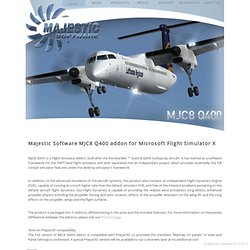
It has started as a software framework for the FNPT level flight simulator and later separated into an independant project, which provides essentially the full cockpit simulator features under the desktop simulator's framework. In addition, to the advanced simulation of the aircraft systems, this product also contains an independent Flight Dynamics Engine (FDE), capable of running at a much higher rate than the default simulator FDE, and free of the inherent problems pertaining to the default aircraft flight dynamics. Our Flight Dynamics is capable of providing the realistic wind simulation, icing effects, enhahced propeller physics including the propeller discing and auto rotation, effects of the propeller airstream on the wing lift and the icing effects on the propeller, wings and the flight surfaces.
Note on Prepar3D compatibility. Bombardier Q400. Bombardier Dash 8. The Bombardier Dash 8 or Q-Series, previously known as the de Havilland Canada Dash 8 or DHC-8, is a series of twin-engined, medium range, turboprop airliners.
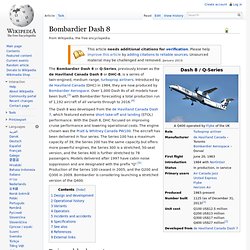
Introduced by de Havilland Canada (DHC) in 1984, they are now produced by Bombardier Aerospace. Over 1,000 Dash 8s of all models have been built,[3] with Bombardier forecasting a total production run of 1,192 aircraft of all variants through to 2016.[4] The Dash 8 was developed from the de Havilland Canada Dash 7, which featured extreme short take-off and landing (STOL) performance. With the Dash 8, DHC focused on improving cruise performance and lowering operational costs. The engine chosen was the Pratt & Whitney Canada PW100.
Design and development[edit] Early −300 cockpit Modern Q400 cockpit In the 1970s, de Havilland Canada had invested heavily in its Dash 7 project, concentrating on STOL and short-field performance, the company's traditional area of expertise. Q400X[edit] Operational history[edit] Regional jet competition[edit] Bombardier Q400. Un article de Wikipédia, l'encyclopédie libre.
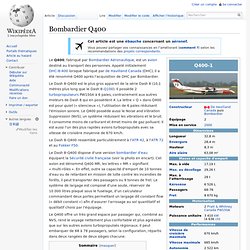
Dash 8Q-400 Aircraft Systems CBT & WBT. Plane Bombardier DASH-8-400. BOMBARDIER DHC8-400. APPROVED: ____________________ DATE: 15 April 2001 Trevor R Owen Team Leader, DHC8-400 Operational Evaluation Team Transport Canada, Safety and Security Commercial & Business Aviation, Operational Standards Place de Ville, Tower C, 330 Sparks Street Ottawa ON K1A 0N8 Telephone: (613) 990-1065 Fax: (613) 954-1602 E-Mail: owent@tc.gc.ca Contents Revision Record Purpose Conduct of OE OET Composition Application of OE Report Pilot Type Rating Requirements Master Common Requirements (MCRS) Master Difference Requirements (MDRS) Acceptable Operator Differences Requirements (ODRS) Tables OE Specifications for Training OE Specifications for Checking OE Specifications for Currency Regulatory Compliance Checklist Alternate Symbology FMS FCOM Alternate Means of Compliance Supporting Documentation Revision Record Note: Revisions to the text will be shown in BOLD type.
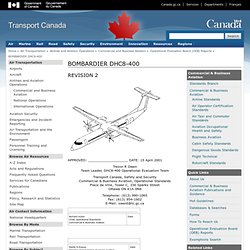
Purpose The following acronyms are used in this report: Conduct of the Operational Evaluation OET Composition No Flap Approach. Proud to fly a Turboprop: Q400 vs ATR72. It’s time for another A vs.
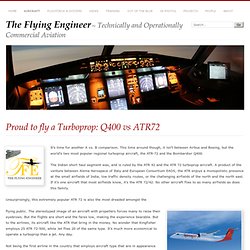
B comparison. This time around though, it isn’t between Airbus and Boeing, but the world’s two most popular regional turboprop aircraft, the ATR-72 and the Bombardier Q400. The Indian short haul segment was, and is ruled by the ATR 42 and the ATR 72 turboprop aircraft. A product of the venture between Alenia Aerospace of Italy and European Consortium EADS, the ATR enjoys a monopolistic presence at the small airfields of India, low traffic density routes, or the challenging airfields of the north and the north east.
If it’s one aircraft that most airfields know, it’s the ATR 72/42. Bombardier Q400 Cockpit - Flight Deck.